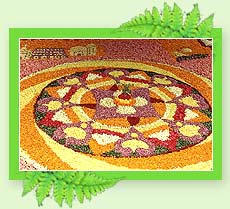The glowing faces of television sellers, motorbike dealers, fashion sellers, street vendors and even flower sellers herald the arrival of Kerala’s national festival Onam. The grand festival of Malayalees is here. The time for Maharaj Mahabali’s majestic tour of Kerala has come closer.
 As the Onam band wagon has started to roll, businessmen in the nook and corners of Kerala are happy, obviously. Keralites will soon set out for an extravagant shopping for Onam celebration.
As the Onam band wagon has started to roll, businessmen in the nook and corners of Kerala are happy, obviously. Keralites will soon set out for an extravagant shopping for Onam celebration.
But what actually is the level of response of various Hindu communities who play the key role in enlivening the memory of king Maveli, whose regime had ended for the qualities of his governance.
For the majority of Hindu communities, Onam celebration has changed a lot. Definitely, the reasons include not only that families have turned ‘nuclear’ and children have stopped collecting flowers for laying pookkalam for their television addiction.
It was the Brahmin community, who changed first or others changed them, rather. It was the Brahmins who led the Hindus in celebrating Onam in the past. But now their Onam celebration has lost its vigor. The change began when the priest community had to give up their property with the Land Reforms Law.
The Brahmin families had received ‘kazcha’ (gifts) from their tenants belonged to lower Hindu communities till the recent past. And Brahmins gave ‘onappudava’ in return. Such rituals were not a show of authoritarian mentality, but a gesture of love and understanding. However, such practices have almost come to a halt.
‘Onappottan’, the person dressed like Mahabali, visits houses on the day of Thiruvonam. Not only the Brahmins but the whole of Hindu community had held onappottan in high esteem as ‘onappottan’ represents king Maveli. But the sanctity of the visit has eroded, since the practice became a business.
“The hereditary right to dress like Maveli had belonged to the Malayan and Munnottan communities in the past. But now even local clubs have started sending ‘onappottan’ to houses. Their only purpose is to make money. They are misutilising the value of a traditional ritual,” says a senior Brahmin priest near Vatakara.
Prior to the visit of ‘onappottan’, Brahmins draw the forms of foot using rice powder from the main door to the important room of their house. The room will be decorated and ‘niranazhi’ and ‘nirapara’ will be placed there. The families offer dress and rice to ‘onappottan’. But such rites are disappearing, says the Brahmin priest.
‘Thiruvathirakkali’, the dance form usually played in Brahmin families during Onam days, is also becoming a rare event. Still, Namboodiri families celebrate Onam with all pomposity if a new person has come to the house by marriage. They take ‘onasadhya’ (Onam feast) after offering it to Lord Ganapati.
Moreover, they conduct special pooja on the day of Thiruvonam at the temples of Vamana, the incarnation of Lord Vishnu, who ended the rule of Mahabali.
Hindu communities used to go to temples on the days of Onam. And they preferred vegetable food on the days of Onam as the days are sacred for them. However, most of the families now prefer meat. This apart, liquor consumption has gone up during Onam days.
Onam celebration varies in other Hindu communit8ies like Nair sections, Thiyya, Chaliya, Pulaya, Paraya, and Adivasi sects like Paniya and Kurichya according to their culture and financial background. However, it is a fact that almost all these communities have almost halted giving offerings to their priest community, Brahmins on the occasion.
The popular saying is that the first Onam belongs to ‘Savarna’ communities like Namboodiri and Nair and the second Onam belongs to the ‘Avarna’ sections like Thiyya. But the saying has no relevance these days since the financial status of various Hindu communities has become almost the same.
Family re-union is still the key ingredient of Onam celebration in most of the Hindu communities. Daughters married off to distance places and sons and their families working at far-away places come to their land to join together for the celebration. The family members distribute ‘onappudava’ to each others.
However, the disappearance of ‘tharavadus’ and the advent of nuclear families have affected the spirit of family get-togethers during Onam. Now the three-member families celebrate Onam in their flats and their father and mother celebrate Onam alone.
Another key item of Onam, the laying of ‘onappookkalam’, also is slowly disappearing. Pookkalam is laid only for pookkalam contests organised by local clubs and other organisations. Other reason for its disappearance is the non-availability of flowers with the filling of paddy fields and urbalisation.
The Thiyya families used to prepare ‘poothara’ and its shelter for laying ‘pookkalam’. The practice has come an end at several regions. Though the Nair families used to spray cow-dung water before laying ‘pookkalam’ on their courtyard, the practice has ended in several families.
‘Kanam vittum Onam unnanam’ (sell property to prepare Onam feast) is a popular saying related to Onam. This saying remembers Malayalees the significance of Onam and the need to celebrate it at all costs. However, almost all Hindu communities except some Adivasi sects need not take the extreme step to celebrate Onam as their members have good jobs either in India or abroad.


